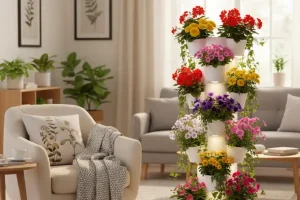Ever wished your balcony or kitchen window could smell like a tiny botanical garden—lavender in the morning, jasmine at dusk, a hint of vanilla when you pass by? A fragrant flower wall makes scent the star.
With the right plants, smart placement, and simple care, you can enjoy continuous perfume from sunrise to bedtime—all in a vertical space that fits small homes and apartments.
This post shows you how to plan a scent-forward wall, choose varieties that bloom at different times of day, keep fragrance strong without overwhelming your space, and maintain clean, healthy plants.
You’ll get a one-day setup plan, easy care routines, and a troubleshooting section so blooms (and scent) keep coming.
Why go vertical for fragrance?
- Big impact, tiny footprint: A slim wall can hold dozens of compact plants, giving you layers of scent without eating floor space.
- Better airflow: Vertical layouts catch breezes that disperse perfume.
- Easy access: Deadheading and pruning at eye level takes minutes.
- Design freedom: Mix day-scented and night-scented plants for a “scent schedule” that matches your routine.
How fragrance actually works (quick and helpful)
- Essential oils develop in petals and leaves. Warmth releases them, but harsh heat can burn off aroma.
- Timing differs by plant: Many species scent strongest in late morning to afternoon (lavender, dianthus), while others intensify at dusk and night (star jasmine, nicotiana).
- Airflow carries scent: A gentle cross-breeze or a small fan on low spreads perfume evenly.
Choose your palette: day, dusk, and night layers
Daytime heroes (sun to bright light)
- Lavender (‘Munstead’, ‘Hidcote’, dwarf types): Compact, classic.
- Miniature roses (repeat bloomers): Old-world perfume in small packages.
- Dianthus (pinks): Clove-spice scent and neat mounds.
- Sweet alyssum: Honey-like fragrance; great filler and pollinator-friendly.
- Heliotrope: Vanilla-cherry notes; protect from extreme heat.
Evening into night (balcony magic)
- Star jasmine (Trachelospermum jasminoides): Pot and train on a slim trellis beside the wall.
- Nicotiana (flowering tobacco): White/lime forms release perfume at dusk.
- Night phlox or evening stock: Gentle, nostalgic scent after sunset.
- Tuberose (warm climates/containers): Big night fragrance; give excellent drainage.
“Brush and release” companions
- Scented geraniums (rose, lemon, mint types), lemon thyme, lemon balm—aroma when touched, perfect near walkways or doorways.
Tip: If your space is small, pick 2–3 daytime and 2 evening scent anchors, then add a couple of “brush” herbs to avoid a muddled mix.
Design the wall for scent and health
- Top row (sunny, hot): Lavender, dwarf roses, heliotrope.
- Middle row (steady light): Dianthus, alyssum, scented geraniums.
- Side trellis or column: Star jasmine for height and night perfume.
- Eye-level “evening pocket”: Nicotiana or night phlox where you sit in the evening.
- Gaps for airflow: Leave a finger-width gap between pockets; air movement keeps fragrances fresh and mildew at bay.
Indoors? Place near a bright window and use a clip fan on low, angled across—not directly at—plants to lift scent without drying them out.
Containers, media, watering: fragrance-friendly basics
- Pots/pockets: 2–5 L for most; roses and jasmine prefer deeper containers (at least 5–10 L if possible).
- Mix: 50% high-quality potting mix + 30% fine bark/perlite for drainage + 20% screened compost for nutrients.
- Watering: Deep and consistent. Let the top inch dry before watering again. Avoid soaking petals—wet blooms fade faster and spot.
- Feeding: Use a bloom-leaning fertilizer (higher potassium than nitrogen) at half strength every 2–3 weeks during active bloom. Too much nitrogen = leaves but fewer flowers (and less scent).
- Mulch: A 1–2 cm layer of fine bark or coco chips keeps roots cool and moisture steady, protecting essential oils.
Pruning and deadheading for nonstop perfume
- Lavender: Light shear after each flush; never cut into old woody stems.
- Miniature roses: Snip spent blooms to the first 5-leaflet leaf; keep foliage dry and clean.
- Dianthus/alyssum: Weekly deadheading prompts more buds.
- Jasmine: After the main bloom, trim and guide stems along the trellis to keep airflow open.
- Nicotiana/night bloomers: Remove spent flower clusters to encourage a second wave.
Seasonal plan (so scent doesn’t fizzle)
- Spring: Plant, pinch tips for branching, establish even moisture.
- Summer: Add 20–30% shade cloth during peak heat to keep oils from burning off and petals from scorching.
- Autumn: Light feeding, cleanup, and pruning; reduce water as growth slows.
- Winter (mild climates or indoors): Keep bright light and steady airflow; many fragrant plants appreciate a brief cool period to rest.
One-day setup plan
Morning — Mount & map
- Install rails/pockets level and secure; add a side trellis for jasmine.
- Stand where you’ll sit in the evening and mark nose-height pockets for night-scented plants.
Midday — Mix & plant
- Fill containers with the airy bloom mix; water to settle.
- Plant top row with sun lovers (lavender, rose), mid row with companions (dianthus, alyssum), and place jasmine on the trellis.
- Keep nicotiana or night phlox at eye level near seating.
Afternoon — Air & water
- Set a clip fan on low (indoors) or confirm a natural cross-breeze outdoors.
- Water at the base; avoid petals.
- Program a morning-only irrigation schedule (manual or timer).
Evening — Scent test
- Step outside/near the wall at morning, afternoon, and dusk to note scent paths.
- Shuffle a plant or two if you want stronger perfume near your favorite chair or window.
Actionable tips to keep scent strong
- Morning harvest: If you dry petals (lavender, rose), snip in the morning when oils are concentrated.
- Rotate pots 90° every two weeks for even growth and bloom distribution.
- Clean leaves gently with a damp cloth if dust dulls fragrance indoors.
- Skip heavy cleaners near indoor walls; strong artificial scents compete with flowers.
- Mix heights and textures: Air can thread through leaves and carry scent better than a flat, packed surface.
Troubleshooting & quick fixes
- Lots of leaves, few flowers: Cut nitrogen, switch to a bloom fertilizer, and increase light hours.
- Petal scorch in heat: Add 20–30% shade cloth during the hottest hours; water earlier in the day.
- Mildew or musty smell: Increase airflow, avoid evening leaf-wetting, thin dense foliage.
- Weak scent overall: Move the wall to brighter light, prune lightly to encourage new flowering wood, and deadhead more often.
- Jasmine won’t bloom: Needs bright light and modest feeding; trim after bloom, not just before.
Conclusion
A fragrant flower wall is more than pretty—it’s a daily mood lift. Layer day and night bloomers, keep airflow gentle, water in the morning, and feed for flowers (not just leaves). With a simple trellis for jasmine, compact lavender and mini roses up top, and a few dusk-perfumed pockets at nose height, you’ll orchestrate scent from breakfast to bedtime—no large garden required.




